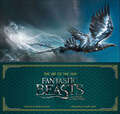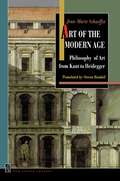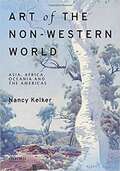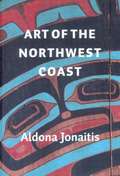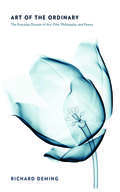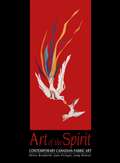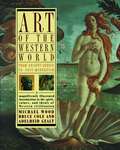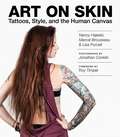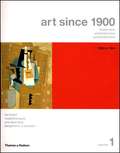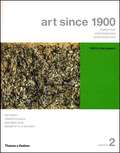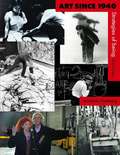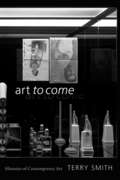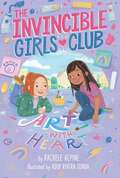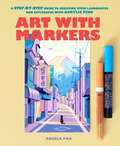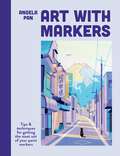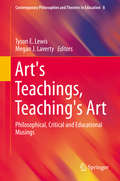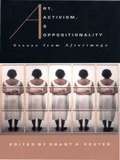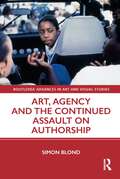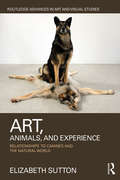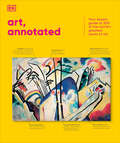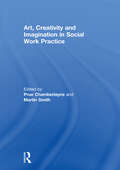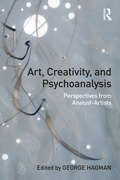- Table View
- List View
Art of the Film: Fantastic Beasts and Where to Find Them
by Dermot PowerAn in-depth, fully illustrated look at the art and artists behind the awe-inspiring world of J.K. Rowling’s Fantastic Beasts and Where to Find Them.Led by Academy Award®–winning production designer Stuart Craig, a number of art departments were responsible for creating the unforgettable characters, locations and beasts from the 2016 fantasy film that expanded on the Wizarding World of Harry Potter. In this beautifully illustrated volume, Dermot Power—a concept artist on the film—takes you on a magical journey through a design process every bit as wonderful as that encountered by Newt Scamander: from the earliest gatherings of the artists, designers and filmmakers to the magical time of the film’s production.Bursting with hundreds of production paintings, concept sketches, storyboards, blueprints and matte paintings, and filled with unique insights about the filmmaking journey from Stuart Craig and the artists themselves, this superb book presents a visual feast for readers, and will welcome fans of Harry Potter films into the world of Fantastic Beasts and Where to Find Them.
Art of the Modern Age: Philosophy of Art from Kant to Heidegger (New French Thought Series #2)
by Jean-Marie SchaefferThis is a sweeping and provocative work of aesthetic theory: a trenchant critique of the philosophy of art as it developed from the eighteenth century to the early twentieth century, combined with a carefully reasoned plea for a new and more flexible approach to art.Jean-Marie Schaeffer, one of France's leading aestheticians, explores the writings of Kant, Schlegel, Novalis, Hegel, Schopenhauer, Nietzsche, and Heidegger to show that these diverse thinkers shared a common approach to art, which he calls the "speculative theory." According to this theory, art offers a special kind of intuitive, quasi-mystical knowledge, radically different from the rational knowledge acquired by science. This view encouraged theorists to consider artistic geniuses the high-priests of humanity, creators of works that reveal the invisible essence of the world. Philosophers came to regard inexpressibility as the aim of art, refused to consider second-tier creations genuine art, and helped to create conditions in which the genius was expected to shock, puzzle, and mystify the public. Schaeffer shows that this speculative theory helped give birth to romanticism, modernism, and the avant-garde, and paved the way for an unfortunate divorce between art and enjoyment, between "high art" and popular art, and between artists and their public.Rejecting the speculative approach, Schaeffer concludes by defending a more tolerant theory of art that gives pleasure its due, includes popular art, tolerates less successful works, and accounts for personal tastes."[A] remarkable work.... [Schaeffer's] writing is governed by ... the ideals of clarity and consequence, the ideas of logic, truth, and evidence.... Schaeffer is so precise and unrelenting a philosophical critic that one wonders how some of the philosophies he anatomizes here can possibly survive the operation."--From the foreword by Arthur C. Danto
Art of the Non-Western World: Asia, Africa, Oceania, and the Americas
by Nancy L. KelkerArt of the Non-Western World: Asia, Africa, Oceania, and the Americas gives students the tools to better understand and appreciate the arts in a global world. It offers an in-depth, contextual exploration of the art from the larger world beyond the European tradition, including painting, sculpture, pottery, graphic arts, and architecture of Asia, the Americas, Africa, Australia, and the Pacific Islands, from the Neolithic to the Contemporary. All new print and electronic versions of Art of the Non-Western World come with access to a full suite of engaging digital learning tools.
Art of the Northwest Coast
by Aldona JonaitisArt of the Northwest Coast is a comprehensive survey of the Native arts of the Pacific Northwest Coast, from Puget Sound to Alaska and from prehistoric times to the present. Incorporating the region's social history with the observations of anthropologists, historians of art, and Native peoples, this groundbreaking volume examines how the upheavals of European contact affected the development of a powerful traditional art. By exploring the distinct origins of each of the area's linguistic groups and their histories, mythologies, and art forms, art historian Aldona Jonaitis reveals how a complex web of factors informed these groups' varied responses to the changes and challenges brought about by contact with Europeans. Art of the Northwest Coast is a cornerstone addition to any library and essential reading for anyone interested in the art of Native cultures.
Art of the Ordinary: The Everyday Domain of Art, Film, Philosophy, and Poetry
by Richard DemingCutting across literature, film, art, and philosophy, Art of the Ordinary is a trailblazing, cross-disciplinary engagement with the ordinary and the everyday. Because, writes Richard Deming, the ordinary is always at hand, it is, in fact, too familiar for us to perceive it and become fully aware of it. The ordinary he argues, is what most needs to be discovered and yet is something that can never be approached, since to do so is to immediately change it.Art of the Ordinary explores how philosophical questions can be revealed in surprising places—as in a stand-up comic’s routine, for instance, or a Brillo box, or a Hollywood movie. From negotiations with the primary materials of culture and community, ways of reading "self" and "other" are made available, deepening one’s ability to respond to ethical, social, and political dilemmas. Deming picks out key figures, such as the philosophers Stanley Cavell, Arthur Danto, and Richard Wollheim; poet John Ashbery; artist Andy Warhol; and comedian Steven Wright, to showcase the foundational concepts of language, ethics, and society. Deming interrogates how acts of the imagination by these people, and others, become the means for transforming the alienated ordinary into a presence of the everyday that constantly and continually creates opportunities of investment in its calls on interpretive faculties.In Art of the Ordinary, Deming brings together the arts, philosophy, and psychology in new and compelling ways so as to offer generative, provocative insights into how we think and represent the world to others as well as to ourselves.
Art of the Spirit: Contemporary Canadian Fabric Art
by Helen Bradfield Joan Pringle Judy RidoutRich colours and arresting designs capture the mood of celebration and joy that characterizes this photographic record of contemporary religious works of art. Chosen for their excellence in design and stitchery, these works represent the achievements of artists who have created art, in fabric, for places of worship. This book celebrates this important artistic expression, a significant part of our heritage. Pieces are selected from communities across Canada: from a small parish on a Micmac reserve in Nova Scotia to a large urban synagogue in Vancouver; from the igloo-shaped cathedral in Iqaluit to a suburban church nestled beside a wildlife march in southwestern Ontario.
Art of the Western World: From Ancient Greece to Post-Modernism
by Bruce Cole Adelheid GealtA good know-how book to gather information about Art progression through the centuries and periods - right from its classical roots in Greece until present day.
Art on Skin: Tattoos, Style, and the Human Canvas
by Lisa Purcell Troy Timpel Marcel Brousseau Nancy Hajeski Jonathan ConklinA celebration of all things tattoo, this visually appealing wealth of tattoo knowledge will have you running for the nearest tattoo artist. The twenty-first century has seen a boom in tattooing, with millions of American's-23 percent of them-boasting ink on their body. This popular pastime is not something to be taken lightly, as there are dozens of aspects to consider when planning your ink. Art on Skin helps with that planning by detailing the different types of art, ink, and artists that pervade the industry.Using striking visuals, Art on Skin showcases the beauty of the art of tattooing and aids in the choosing of a style, with detailed descriptions of the many different styles of tattoos, including fine art, cartoon characters, wildlife, and many more. The full-color photographs within these pages will leave you with dreams of your own pieces, and stories from others who have lived the tattoo experience will keep you from stumbling upon unwelcome surprises. This is the perfect book for tattoo lovers and prospective tattoo junkies of all kinds.
Art on Trial: Art Therapy in Capital Murder Cases
by David GussakA man kidnaps his two children, murders one, and attempts to kill the other. The prosecution seeks the death penalty, while the defense employs an unusual strategy to avoid the sentence. The defendant's attorneys turn to more than 100 examples of his artwork, created over many years, to determine whether he was mentally ill at the time he committed the crimes. Detailing an outstanding example of the use of forensic art therapy in a capital murder case, David Gussak, an art therapist contracted by the defense to analyze the images that were to be presented as evidence, recounts his findings and his testimony in court, as well as the future implications of his work for criminal proceedings. <P><P>Gussak describes the role of the art therapist as an expert witness in a murder case, the way to use art as evidence, and the conclusions and assessments that professionals can draw from a defendant's artworks. He examines the effectiveness of expert testimony as communicated by the prosecution, defense, and court, and weighs the moral, ethical, and legal consequences of relying on such evidence. For professionals and general readers, this gripping volume presents a convincing account of the ability of art to reflect a damaged and dangerous psyche. A leading text on an emerging field, Art on Trial demonstrates the practical applications of an innovative approach to clinical assessment and treatment.
Art since 1900: Modernism, Antimodernism, Postmodernism (Volume 1, 1900-1944)
by Hal Foster Yve-Alain Bois Benjamin H. D. Buchloh Rosalind E. KraussIn this groundbreaking and original work of scholarship, four of the most influential and provocative art historians of our time have come together to provide a comprehensive history of art in the twentieth century, an age when artists in the United States, Europe, and elsewhere sought to overturn the traditions of the past and expectations of the present in order to invent new practices and forms. Adopting a unique year-by-year approach, Foster, Krauss, Bois, and Buchloh present more than 50 short essays, each focusing on a crucial event the creation of a seminal work, the publication of an artistic manifesto, the opening of a major exhibition to tell the story of the dazzling diversity of practice and interpretation that characterizes the art of the period. All the turning points and breakthroughs of modernism and postmodernism are explored in depth, as are the frequent and sustained antimodernist reactions that proposed alternative visions of art and the world. Illustrating the authors' texts are more than 300 of the most important works of the century, many reproduced in full color. The book's flexible structure and extensive cross-referencing allow readers to follow any one of the many narratives that unfold, whether that be the history of a medium such as photography or painting, the development of art in a particular country, the influence of a movement such as surrealism or feminism, or the emergence of a stylistic or conceptual category like abstraction or minimalism. Boxes give further background information on the important figures and issues. In their insightful introductions, the four authors explain the different methods of art history at work in the book, providing the reader with the conceptual tools for further study. A roundtable discussion at the close of the book considers the questions raised by the preceding decades and look ahead to the art of the future. A glossary of terms and concepts completes this extraordinary volume.
Art since 1900: Modernism, Antimodernism, Postmodernism (Volume 2, 1945-Present)
by Hal Foster Yve-Alain Bois Benjamin H. D. Buchloh Rosalind E. KraussIn this groundbreaking and original work of scholarship, four of the most influential and provocative art historians of our time have come together to provide a comprehensive history of art in the twentieth century, an age when artists in the United States, Europe, and elsewhere sought to overturn the traditions of the past and expectations of the present in order to invent new practices and forms. Adopting a unique year-by-year approach, Foster, Krauss, Bois, and Buchloh present more than 100 short essays, each focusing on a crucial event the creation of a seminal work, the publication of an artistic manifesto, the opening of a major exhibition to tell the story of the dazzling diversity of practice and interpretation that characterizes the art of the period. All the turning points and breakthroughs of modernism and postmodernism are explored in depth, as are the frequent and sustained antimodernist reactions that proposed alternative visions of art and the world. Illustrating the authors' texts are more than 600 of the most important works of the century, many reproduced in full color. The book's flexible structure and extensive cross-referencing allow readers to follow any one of the many narratives that unfold, whether that be the history of a medium such as photography or painting, the development of art in a particular country, the influence of a movement such as surrealism or feminism, or the emergence of a stylistic or conceptual category like abstraction or minimalism. Boxes give further background information on the important figures and issues. In their insightful introductions, the four authors explain the different methods of art history at work in the book, providing the reader with the conceptual tools for further study. Two roundtable discussions one at midcentury, the other at the close of the book consider the questions raised by the preceding decades and look ahead to the art of the future. A glossary of terms and concepts completes this extraordinary volume.
Art since 1940
by Jonathan David FinebergThis comprehensive and authoritative textbook illustrates art from the 1940's and stresses the individuality of the artists in relation to their political, social, and cultural contexts. The book focuses on the meaning of the major works and innovations. It features nearly 600 illustrations (approximately half in color) representing art since 1940, both in Europe and America. It explores the full range of periods, artists, and movements: New York in the Forties; Calder, Hofmann, Gorky, Motherwell, De Kooning; Existentialism (Pollock, Newman, Rothko, David Smith); The New European Masters of the Late Forties (Dubuffet, Giacometti, Bacon), plus so much more. For anyone interested in Postwar Art.
Art to Come: Histories of Contemporary Art
by Terry SmithIn Art to Come Terry Smith—who is widely recognized as one of the world's leading historians and theorists of contemporary art—traces the emergence of contemporary art and further develops his concept of contemporaneity. Smith shows that embracing contemporaneity as both a historical concept and a condition of the globalized world allows us to grasp how contemporary art exists in a fluid space of increasing interdependencies, multiple contemporaneous modernities, and persistent inequalities. Throughout these essays, Smith offers systematic proposals for writing contemporary art's histories while assessing how curators, critics, philosophers, artists, and art historians are currently doing so. Among other topics, Smith examines the intersection of architecture with other visual arts, Chinese art since the Cultural Revolution, how philosophers are theorizing concepts associated with the contemporary, Australian Indigenous art, and the current state of art history. Art to Come will be essential reading for artists, art students, curators, gallery workers, historians, critics, and theorists.
Art with Heart (The Invincible Girls Club #2)
by Rachele AlpineEmelyn and her three BFFs spread positive messages to fight back against bullying in this second installment of the relatable and empowering The Invincible Girls Club chapter book series—featuring backmatter with profiles on real-life anti-bullying activists!Someone is writing mean messages about Emelyn and other kids in her grade on pieces of paper and sticking them to lockers and bathroom walls. When Emelyn discovers a classmate hiding in the bathroom crying about the mean words written about her, Emelyn brings this problem to The Invincible Girls. Together, they decide to fight the negativity with positivity! Emelyn, Laura, Ruby, and Myka spread words of kindness and cheerful images all over the place to cancel out the negative ones. But they keep running into speed bumps along the way—and Emelyn isn&’t sure she&’s the right person to lead the charge. Can the girls help stop the bullying in their school? And can Emelyn ultimately find her own voice?
Art with Markers: A Step-by-Step Guide to Creating Vivid Landscapes and Cityscapes with Acrylic Pens
by Angela PanA beautiful and accessible guide to making art with markers, from beloved artist Angela Pan.Versatile and approachable, marker pens are the must-have material for aspiring artists. Like watercolor, acrylic paint markers are beginner-friendly—you need just a bit of targeted instruction to achieve the styles you admire online. But where to begin?In Art with Markers, Angela Pan gives straightforward and thorough guidance on beginning your journey to becoming the artist you want to be. This handy art instruction book includes:22 illustrated, step-by-step projectsColor mixing, drawing, and blending techniquesTroubleshooting tips for preparing, cleaning, and storing markersWork through these pages and you’ll have your own collection of stunning landscape images and all the tools you need to turn your imagination into original marker art. Whether you’re curious to try a new medium or are already a fan of marker brands like Posca and Molotow, this book will be the perfect companion on your creative journey.EASY-TO-FOLLOW GUIDE: Step-by-step instructions make it possible for artists of all levels to enjoy and learn. This is an essential resource for art students and hobbyists wanting to add markers to their repertoire.POPULAR MARKER ARTIST: Angela Pan's dreamy landscapes and cityscapes, inspired by her travels, have won her many fans. She has created art kits and a series of sketchbooks for Mossery, been exhibited at Gallery Nucleus, and offers a drawing class on Domestika. WONDERFUL ART GIFT: Beautifully packaged, with full-color artwork throughout, this makes a great present alongside a set of markers. Perfect for the aspiring artist or art lover in your life!Perfect for:Aspiring creatives and art studentsExperienced artists branching out into the marker mediumFans of Angela Pan's art and tutorialsArt journalers and travel journalersFans of manga/anime and manga/anime-style illustrationGift-giving for birthday, graduation, bon voyage, or any special occasion
Art with Markers: Tips & techniques for getting the most out of your paint markers
by Angela PanVersatile and accessible, acrylic paint markers are the must-have art material for beginner and experienced artists alike. Under the expert guidance of artist and educator Angela Pan, learn how to get to grips with your acrylic marker set and really master the medium.Begin with an introduction to using your markers, with tips on materials, choosing colours and mixing, including specific tips for Posca and Molotow acrylic markers. Next, learn how to draw different kinds of flowers and trees. Once you have these under your belt, move on to 22 step-by-step projects that show you how to create stunning landscapes and city scenes using your acrylic markers.Projects include:· Snow-covered mountain· Sunrise in Tuscany· Blue hour in Lisbon· Sunset in the Dolomites· Japanese Diner· Zurich at Twilight
Art's Teachings, Teaching's Art: Philosophical, Critical and Educational Musings (Contemporary Philosophies and Theories in Education #8)
by Tyson Lewis Megan LavertyThis volume examines the interface between the teachings of art and the art of teaching, and asserts the centrality of aesthetics for rethinking education. Many of the essays in this collection claim a direct connection between critical thinking, democratic dissensus, and anti-racist pedagogy with aesthetic experiences. They argue that aesthetics should be reconceptualized less as mere art appreciation or the cultivation of aesthetic judgment of taste, and more with the affective disruptions, phenomenological experiences, and the democratic politics of learning, thinking, and teaching. The first set of essays in the volume examines the unique pedagogies of the various arts including literature, poetry, film, and music. The second set addresses questions concerning the art of pedagogy and the relationship between aesthetic experience and teaching and learning. Demonstrating the flexibility and diversity of aesthetic expressions and experiences in education, the book deals with issues such as the connections between racism and affect, curatorship and teaching, aesthetic experience and the common, and studying and poetics. The book explores these topics through a variety of theoretical and philosophical lenses including contemporary post-structuralism, psychoanalysis, phenomenology, critical theory, and pragmatism.
Art, Activism, and Oppositionality: Essays from Afterimage
by Grant H. KesterThere is a common perception in the arts today that overtly activist artæoften seen to sacrifice an aesthetic pleasure for a subversive oneæis no longer in fashion. In bringing together sixteen of the most important essays on activist and community-based art from the pages of Afterimageæone of the most influential journals in the media and visual arts fields for more than twenty-five yearsæGrant H. Kester demonstrates that activist art, far from being antithetical to the true meaning of the aesthetic, can be its most legitimate expression.Forging a style of criticism where aesthetic, critical, theoretical, and activist concerns converge, Afterimage has shaped American debates around the politics of visual production and arts education while offering a voice to politically involved artists and scholars. Art, Activism, and Oppositionality insists not only on the continuing relevance of an activist stance to contemporary art practice and criticism, but also on the significance of an engaged art practice that is aligned with social or political activism. With essays that span fifteen yearsæroughly from Ronald Reagan's 1980 presidential win to the 1994 Republican victories in Congress, a period marked by waning public support for the arts and growing antagonism toward activist art æArt, Activism, and Oppositionality confronts issues ranging from arts patronage, pedagogy, and the very definitions of art and activism to struggles involving AIDS, reproductive rights, sexuality, and racial identity.Art, Activism, and Oppositionality will interest students and scholars of contemporary art history, media studies, cultural studies, and the fine arts, as well as, arts activists, critics, and arts administrators.Contributors. Maurice Berger, Richard Bolton, Ann Cvetkovich, Coco Fusco, Brian Goldfarb, Mable Haddock, Grant H. Kester, Ioannis Mookas, Chiquita Mullins Lee, Darrell Moore, Lorraine O'Grady, Michael Renov, Martha Rosler, Patricia Thomson, David Trend, Charles A. Wright Jr., Patricia R. Zimmerman
Art, Agency and the Continued Assault on Authorship (Routledge Advances in Art and Visual Studies)
by Simon BlondThis book presents a counter-history to the relentless critique of the humanist subject and authorial agency that has taken place over the past fifty years. It is both an interrogation of that critique and the tracing of an alternative narrative from Romanticism to the twenty-first century which celebrates the agency of the artist as a powerful contribution to the wellbeing of the community. It does so through arguments based on philosophical aesthetics and cultural theory interspersed with case histories of particular artists. It also engages with a second issue that cannot be separated from the first. This is the question of what the role and purpose of art is in society. This has become particularly important since the 1990s because of the "social turn" in art in which it is claimed that the only valid role for art was one that had explicit social consequences. This book argues that a political role for art is valuable, but not the only one that can be envisaged nor indeed is it the most obvious or most important. Art has other social roles both as a means to engender empathy and community, and to re-enchant a world bereft of meaning and reduced to material values. The book will appeal to practising artists as well as scholars working in art history, philosophy, aesthetics, and curatorial studies.
Art, Angst, and Trauma: Right Brain Interventions with Developmental Issues
by Doris Banowsky ArringtonArrington, a licensed clinical psychologist, brings together 15 essays on the use of art therapy with children who are seriously ill, in foster care, or physically and emotionally traumatized.
Art, Animals, and Experience: Relationships to Canines and the Natural World (Routledge Advances in Art and Visual Studies)
by Elizabeth SuttonElizabeth Sutton, using a phenomenological approach, investigates how animals in art invite viewers to contemplate human relationships to the natural world. Using Rembrandt van Rijn’s etching of The Presentation in the Temple (c. 1640), Joseph Beuys’s social sculpture I Like America and America Likes Me (1974), archaic rock paintings at Horseshoe Canyon, Canyonlands National Park, and examples from contemporary art, this book demonstrates how artists across time and cultures employed animals to draw attention to the sensory experience of the composition and reflect upon the shared sensory awareness of the world.
Art, Annotated: The World's 500 Greatest Paintings Explained
by DKA stunning art gallery in a book, art, annotated spans more than 3,000 years of paintings, sculptures, and prints.Combining reproductions of each work of art with precise annotations and visual analysis, it is an expertly curated selection of the finest art ever created.Immerse yourself in this book and learn all about art - how Michelangelo painted nudes, what cubism is, and where abstraction came from. Discover ancient Egyptian frescoes, read the visual clues to Leonardo da Vinci's Last Supper, and find out what inspired Louise Bourgeois and Banksy.In this art book, you will find:Art from all over the world exploring key elements such as composition, color, technique, and symbolism.Profiles the work of more than 450 artists from across the world and many different cultures, covering every period and major art movement.Art set in its historical context, which makes art, annotated a complete overview of art history.An optional 32-page directory of biographies of all the artists featured at the back of the book.Packed with information and full of inspiration, art, annotated brings the finest paintings and sculptures right into your home. It is the ultimate history of art and visual sourcebook for all art lovers.
Art, Anthropology and the Gift (Criminal Practice Ser.)
by Roger SansiIn recent decades, the dialogue between art and anthropology has been both intense and controversial. Art, Anthropology and the Gift provides a much-needed and comprehensive overview of this dialogue, whilst also exploring the reciprocal nature of the two subjects through practice, theory and politics. Fully engaging with anthropology and art theory, this book innovatively argues that art and anthropology don’t just share methodologies, but also deeper intellectual, theoretical and even political concerns, inviting scholars and students alike to look at this contentious relationship in a more critical light. One of the central arguments of the book is that the problem of the ‘gift’ has been central to both anthropological and artistic practice. This very idea connects the different chapters on topics including aesthetics, politics, participation and fieldwork.
Art, Creativity and Imagination in Social Work Practice.
by Prue Chamberlayne and Martin SmithHarnessing the inspiration available from the arts and the imagination brings to life sensitive and effective social work practice. Workers feel most satisfied while service users and communities are more likely to benefit when creative thinking can be applied to practice dilemmas. Drawing on contributions from Canada, England and Utrecht this book illustrates the transforming effect of creatively applied thinking to social problems. The first part of the book considers how use of the self can be enhanced by analytic reflection and application to difficulties facing individuals and communities. The second part shows psychodynamic theory to be a valuable aid when thinking about issues faced by social workers facing threats and accusations, therapeutic work with children and restorative youth justice. The third part of the book considers the implications of working with the arts in community settings – an ex-mining community in North West England, the Tate Gallery in London and the ‘cultural capital’ of Liverpool. Taken as a whole these chapters combine to inspire and provoke thought of how the arts and the imagination can be used creativity to help service users confronted by problems with living and the workers who attempt to get alongside them to think about these.This book was published as a special issue of the Journal of Social Work Practice.
Art, Creativity, and Psychoanalysis: Perspectives from Analyst-Artists
by George HagmanArt, Creativity, and Psychoanalysis: Perspectives from Analyst-Artists collects personal reflections by therapists who are also professional artists. It explores the relationship between art and analysis through accounts by practitioners who identify themselves as dual-profession artists and analysts. The book illustrates the numerous areas where analysis and art share common characteristics using first-hand, in-depth accounts. These vivid reports from the frontier of art and psychoanalysis shed light on the day-to-day struggle to succeed at both of these demanding professions. From the beginning of psychoanalysis, many have made comparisons between analysis and art. Recently there has been increasing interest in the relationship between artistic and psychotherapeutic practices. Most important, both professions are viewed as highly creative with spontaneity, improvisation and aesthetic experience seeming to be common to each. However, differences have also been recognized, especially regarding the differing goals of each profession: art leading to the creation of an art work, and psychoanalysis resulting in the increased welfare and happiness of the patient. These issues are addressed head-on in Art, Creativity, and Psychoanalysis: Perspectives from Analyst-Artists. The chapters consist of personal essays by analyst/artists who are currently working in both professions; each has been trained in and is currently practicing psychoanalysis or psychoanalytic psychotherapy. The goal of the book is to provide the audience with a new understanding of psychoanalytic and psychotherapeutic processes from the perspective of art and artistic creativity. Drawing on artistic material from painting, poetry, photography, music and literature, the book casts light on what the creative processes in art can add to the psychoanalytic endeavor, and vice versa. Art, Creativity, and Psychoanalysis: Perspectives from Analyst-Artists will appeal to psychoanalysts and psychoanalytic psychotherapists, theorists of art, academic artists, and anyone interested in the psychology of art.
